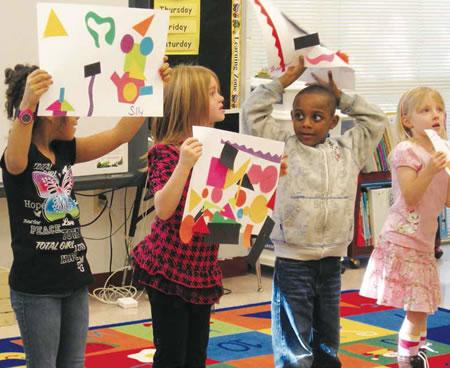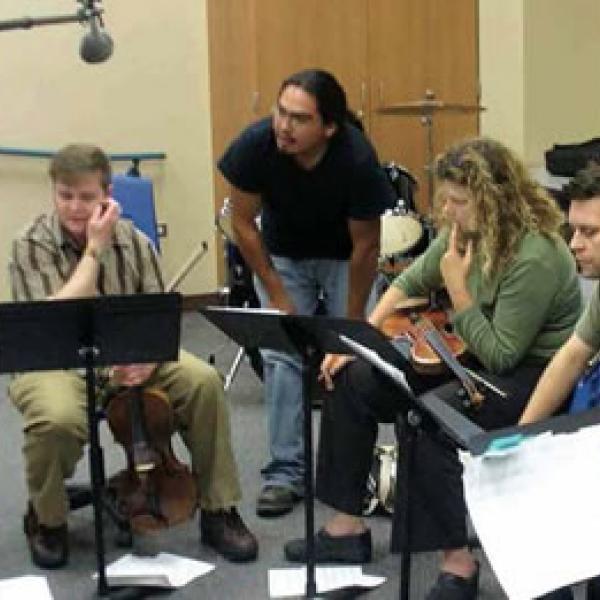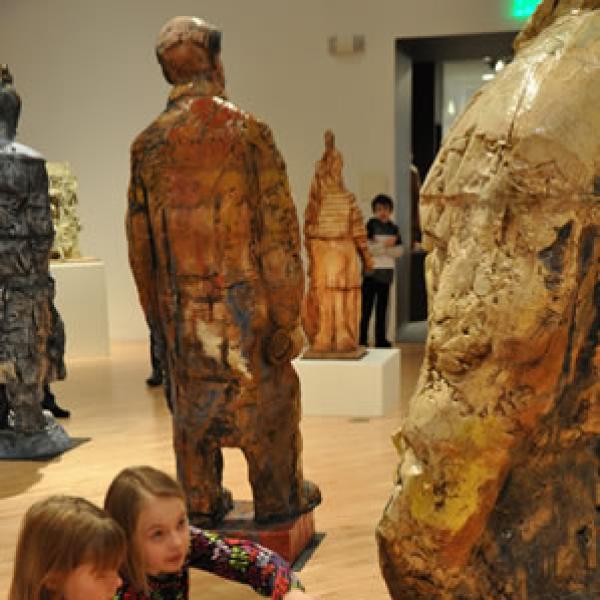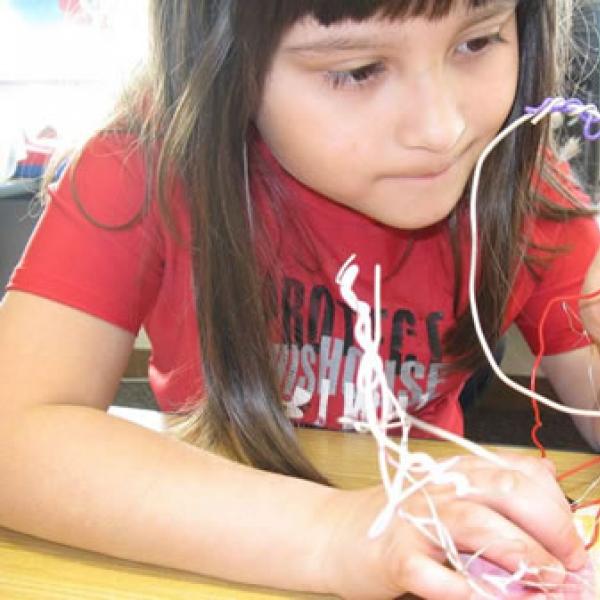It Takes a Community

The morning bell rings at Gatesville Elementary in rural Gates County, North Carolina, which approximately 12,200 residents call home and where nearly a quarter of the population liveS below the poverty line. Students gather in their classrooms, attendance is taken, homework is collected, and everyone settles in for a day of learning. But rather than return to their desks for a day of academic lecture, students will spend the school hours exploring geometry through dance, the water cycle through a painting, and a new book through sculpture. These students and their teachers are part of a growing network of schools across the nation participating in the A+ Schools Program, which integrates the arts into the learning process.
The nationally recognized pioneer arts education program has been incorporated into two of Gates County's five public schools, Gatesville Elementary and T.S. Cooper Elementary. Building on the success of those two schools in providing a broad, integrated, arts-based curriculum that engages and motivates the students, Gates County, with the help of a recent NEA grant, will begin the A+ Schools training process for the district's three remaining schools.

The University of North Carolina's Thomas S. Kenan Institute for the Arts launched the A+ Schools Program in 1995. The concept was ambitious: develop a program for comprehensive school reform that uses the arts as an interactive vehicle for teaching and learning across all subjects. Under the leadership of the North Carolina Arts Council, the A+ Program has grown to a network of more than 40 schools across the state and has provided more than 10,000 teachers with training. The program has also recently launched into other states. Oklahoma, Louisiana, and Arkansas have their own A+ School Programs in place, for a grand total of 120 A+ schools across the nation.
The A+ Schools Program was one aspect of North Carolina Arts Council's accomplishments during their participation in the NEA's first class of theEducation Leaders Institute (ELI) in 2008. For four years, ELI has brought together artists, educators, policymakers, and community and school leaders for a three-day institute to challenge assumptions and strategize on how to advance the arts as part of a comprehensive education (a report on lessons learned from the initiative will be published by the NEA in summer 2013). The arts council determined during that session that continuing to grow A+ schools in the state would benefit students and the community -- and bringing in all the schools in Gates County is part of that strategy.

Michelle Burrows, director of the A+ Schools Program at the North Carolina Arts Council, has seen first-hand the powerful impacts of the arts in the classroom. "We are looking at the arts in three ways: arts education, arts integration, and arts exposure," said Burrows. "We often hear people say there's a hum, or a buzz, when you walk into an A+ school because the kids are so active in their learning."
In Gates County, that buzz has grown into a powerful force. Over the last three years, both Gatesville Elementary School and T.S. Cooper Elementary School have primarily shown increased student achievement in both math and reading. Both schools performed between six to 14 percent higher in reading and approximately seven percent higher in math when compared to statewide North Carolina school performance levels. Over the next two years, the A+ Schools Program will serve as many as 1,200 Gates County students and 115 faculty members. Once the three remaining schools in the county complete their A+ training, the county's public school system will be the first district in North Carolina to include all of its schools in the A+ School network.

Teaching North Carolina's required curriculum in A+ Schools involves a collaborative, multidisciplinary approach that weaves the arts into every aspect of a child's learning. According to Barry Williams, superintendent of Gates County Schools, the A+ whole-school reform model not only offers unprecedented opportunity for arts access but also allows students to use the arts as an intellectual compass. "Integrating the arts into the curriculum in rural schools allows the teachers to reach more of their students in more ways," said Williams. "The use of music, art, theater, dance, and media to teach the state-mandated curriculum will allow for a higher level of student engagement. We cannot always take the children to the arts experiences, but we can bring the arts experiences to them."
To become an A+ school, each institution's faculty participates in the Five-Day Institute. Led by A+ Fellows -- practicing classroom teachers and specialists, administrators, teaching artists, and writers -- the institute provides intensive and inspiring professional development for teachers.
"We tailor our training for the specifications of each individual school and we make sure to have complete buy-in from the entire school community," said Burrows. "The whole faculty is involved and has agreed to participate before the training ever begins. We've even had bus drivers and cafeteria workers participate. What it boils down to is the size of the community. The smaller the community, the more impact those support staff have on the school. Everybody is working for those kids."
Williams agreed. "There is much truth to the age-old saying: ‘It takes a village to raise a child.' Similarly, it truly takes a community to help complete a school," he said. "In a rural community, the importance of the partnership is heavily underscored. By banding together to support their school, the strength of the community increases. In a rural area -- where families live spread out on farms, small neighborhoods, and villages -- having a shared stake in their community's school provides a way for there to be more common ground that crosses socio-economic lines."
After completing the initial training courses at the program's Five-Day Institute, teachers from Buckland Elementary School, Central Middle School, and Gates County High School will be provided with ongoing, high-quality professional development over a three-year period. A+ Fellows continue to offer both professional development support and in-classroom instruction for A+ teachers and faculty during each school's three-year training program.
Joan Certa-Moore is one of North Carolina's A+ Fellows. A trained dancer and veteran arts educator with 29 years of experience, she believes the A+ Program is one of the healthiest ways to learn, for teachers and students alike. She also stresses the importance of the program's continued professional development, which has proven to be a major contributor to A+'s success.
"With the A+ professional development, you have practitioners teaching other practitioners in what is a very powerful and affirming experience of collaborating with other like-minded public educators," said Certa-Moore. "We work with the teachers both in and out of the classroom. They invite us in their teaching space and observe as I teach their students from the beginning to end as the children create a movement product based on a concept that the teachers would typically be teaching. We debrief as partners and there is a real dialogue."
In their report, Reinvesting in Arts Education: Winning America's Future Through Creative Schools, the President's Committee on the Arts and the Humanities recognizes North Carolina's A+ program as an effective, research-based strategy for sustainable school reform. The report notes that the program has shown consistent gains in "student achievement, the schools' engagement of parents and community, as well as other measures of learning and success" throughout 12 years of research findings. The schoolwide value of the A+ system has also shown to benefit "higher proportions of disadvantaged and minority students" as research indicates an equal performance level of disadvantaged A+ students when compared to more advantaged schools.
But beyond test scores, A+ Schools are teaching one of the most important skills needed to succeed in the 21st century: creativity. As teachers find new avenues to engage and motivate their classrooms, students are learning the out-of-the-box thinking that is so valued in today's creative economy. With the A+ arts model as their academic companion, the future for A+ Gates County students is whatever their imagination holds.









